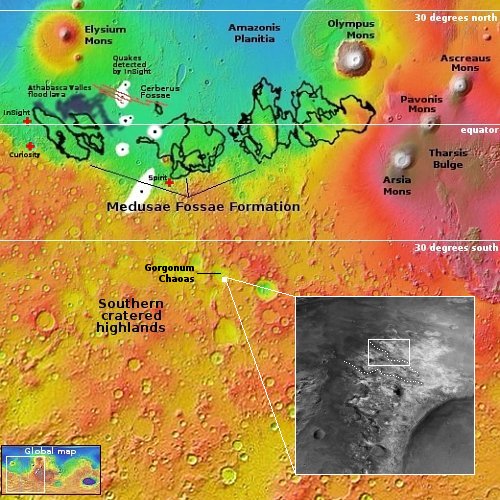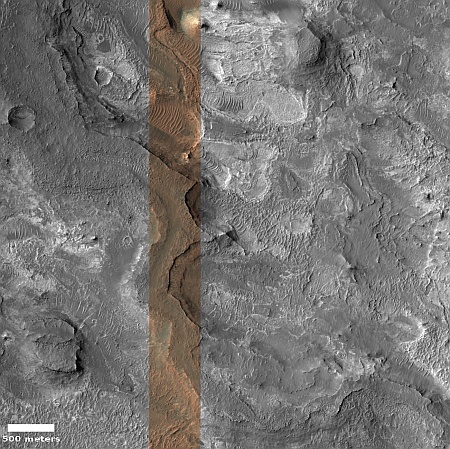Meandering Martian ridges flowing down from crater rim
Cool image time! The picture to the right, rotated, cropped, reduced, and enhanced to post here, was taken on February 9, 2024 by the high resolution camera on Mars Reconnaissance Orbiter (MRO). It shows a good example of the typically rough region inside the southern cratered highlands of Mars.
Note the ripple dunes that fill the low areas. The volcanic ash from Mars’ past volcanic history has become trapped here, with those ripple dunes suggesting the direction of the prevailing winds to the southeast.
The bright areas also suggest there is interesting mineralogy just below the surface. The 100-foot-high mesa near the picture’s top suggests a lot of erosion has occurred here, with its top suggesting the elevation of the surface a long time ago.
The most interesting feature however is the meandering ridge that starts at the lower right and weaves to the upper left.

The white dot on the overview map marks this location, inside a large 100-mile-wide depression dubbed Gorgonum Chaos because of its knobby chaos terrain. The rectangle inside the inset shows the area covered by the picture above. The two dotted lines trace the routes of two similar meandering ridges, both appearing to flow about eight miles down the slope from the rim of an unnamed 15-mile-wide crater.
The scientists label these ridges “inverted channels.” They believe that once these ridges were flow canyons carved by either water or glacial ice, or possibly they were formed shortly after the crater impact, when impact melt flowed down from the crater rim. Those processes compacted the channel floor, or left behind a dike of hardened lava. When the surrounding landscape was eroded away, those channels resisted that erosion and ended up as meandering ridgelines.
Side note: I do these cool images because I am fascinated with the exploration of the unknown, and MRO is right now providing us a window into the unknown on Mars. How can I resist not exploring it?
I wonder sometimes however if my readers even look at these images or read these posts, considering how few comments these cool images get. It appears people today are only interested in politics, which I agree is very important, but not the whole world.
On Christmas Eve 1968 three Americans became the first humans to visit another world. What they did to celebrate was unexpected and profound, and will be remembered throughout all human history. Genesis: the Story of Apollo 8, Robert Zimmerman's classic history of humanity's first journey to another world, tells that story, and it is now available as both an ebook and an audiobook, both with a foreword by Valerie Anders and a new introduction by Robert Zimmerman.
The print edition can be purchased at Amazon or from any other book seller. If you want an autographed copy the price is $60 for the hardback and $45 for the paperback, plus $8 shipping for each. Go here for purchasing details. The ebook is available everywhere for $5.99 (before discount) at amazon, or direct from my ebook publisher, ebookit. If you buy it from ebookit you don't support the big tech companies and the author gets a bigger cut much sooner.
The audiobook is also available at all these vendors, and is also free with a 30-day trial membership to Audible.
"Not simply about one mission, [Genesis] is also the history of America's quest for the moon... Zimmerman has done a masterful job of tying disparate events together into a solid account of one of America's greatest human triumphs."--San Antonio Express-News
Cool image time! The picture to the right, rotated, cropped, reduced, and enhanced to post here, was taken on February 9, 2024 by the high resolution camera on Mars Reconnaissance Orbiter (MRO). It shows a good example of the typically rough region inside the southern cratered highlands of Mars.
Note the ripple dunes that fill the low areas. The volcanic ash from Mars’ past volcanic history has become trapped here, with those ripple dunes suggesting the direction of the prevailing winds to the southeast.
The bright areas also suggest there is interesting mineralogy just below the surface. The 100-foot-high mesa near the picture’s top suggests a lot of erosion has occurred here, with its top suggesting the elevation of the surface a long time ago.
The most interesting feature however is the meandering ridge that starts at the lower right and weaves to the upper left.

The white dot on the overview map marks this location, inside a large 100-mile-wide depression dubbed Gorgonum Chaos because of its knobby chaos terrain. The rectangle inside the inset shows the area covered by the picture above. The two dotted lines trace the routes of two similar meandering ridges, both appearing to flow about eight miles down the slope from the rim of an unnamed 15-mile-wide crater.
The scientists label these ridges “inverted channels.” They believe that once these ridges were flow canyons carved by either water or glacial ice, or possibly they were formed shortly after the crater impact, when impact melt flowed down from the crater rim. Those processes compacted the channel floor, or left behind a dike of hardened lava. When the surrounding landscape was eroded away, those channels resisted that erosion and ended up as meandering ridgelines.
Side note: I do these cool images because I am fascinated with the exploration of the unknown, and MRO is right now providing us a window into the unknown on Mars. How can I resist not exploring it?
I wonder sometimes however if my readers even look at these images or read these posts, considering how few comments these cool images get. It appears people today are only interested in politics, which I agree is very important, but not the whole world.
On Christmas Eve 1968 three Americans became the first humans to visit another world. What they did to celebrate was unexpected and profound, and will be remembered throughout all human history. Genesis: the Story of Apollo 8, Robert Zimmerman's classic history of humanity's first journey to another world, tells that story, and it is now available as both an ebook and an audiobook, both with a foreword by Valerie Anders and a new introduction by Robert Zimmerman.
The print edition can be purchased at Amazon or from any other book seller. If you want an autographed copy the price is $60 for the hardback and $45 for the paperback, plus $8 shipping for each. Go here for purchasing details. The ebook is available everywhere for $5.99 (before discount) at amazon, or direct from my ebook publisher, ebookit. If you buy it from ebookit you don't support the big tech companies and the author gets a bigger cut much sooner.
The audiobook is also available at all these vendors, and is also free with a 30-day trial membership to Audible.
"Not simply about one mission, [Genesis] is also the history of America's quest for the moon... Zimmerman has done a masterful job of tying disparate events together into a solid account of one of America's greatest human triumphs."--San Antonio Express-News



I look over every picture, looking for anomalies or something I could comment on. I am intrigued by the fact that this is an alien world.
The only thing that I found today is more sky scraper peaks resembling a thorn/witch hat. Because the picture was taken from above, look at the length and shape of the shadow that they cast. One in the lower left corner of the original picture, zoom in tight. Another closer to the top just right of the center color band.
I hope one day they have a fleet of helium balloons with solar panel tops and a camera package no larger than a cell phone. Three “CO2 sized” cartridges filled with liquid helium will keep it afloat for years perhaps, dropping empty canisters like ballast. A small compressor no larger than the vibrating motor in your cell phone will adjust the buoyancy for closer pictures, or night time safety minimal height.
A propeller for steering might add too much weight, but think of the panoramas it could take so we could see the actual spires, and the depths of the canyons.
They would also map the surface and get magnetic data of iron deposits, gravitational anomalies, and whatever else that could fit in a cell phone sized science package miniaturized for sensing/gathering data.
Politics is important, especially when we’re seeing the breakdown of a first world nation in modern times, self-destructing into what could become a dark age. The sort of thing that will affect everyone, unless something changes drastically very soon to change the course of events.
I do enjoy these Cool Images and your interpretations. My daily routine into the increasingly crazy digital world we find ourselves begins with BtB, along with other space related sites. While not commenting on many, I do view and read each one. One nagging thought I have is how will future colonists harvest, transport and process the ice they find? A story keeps building in my mind…
Robert,
Please do not be discouraged whenever we do not comment on one of your cool images. We are fascinated, perhaps into speechlessness.